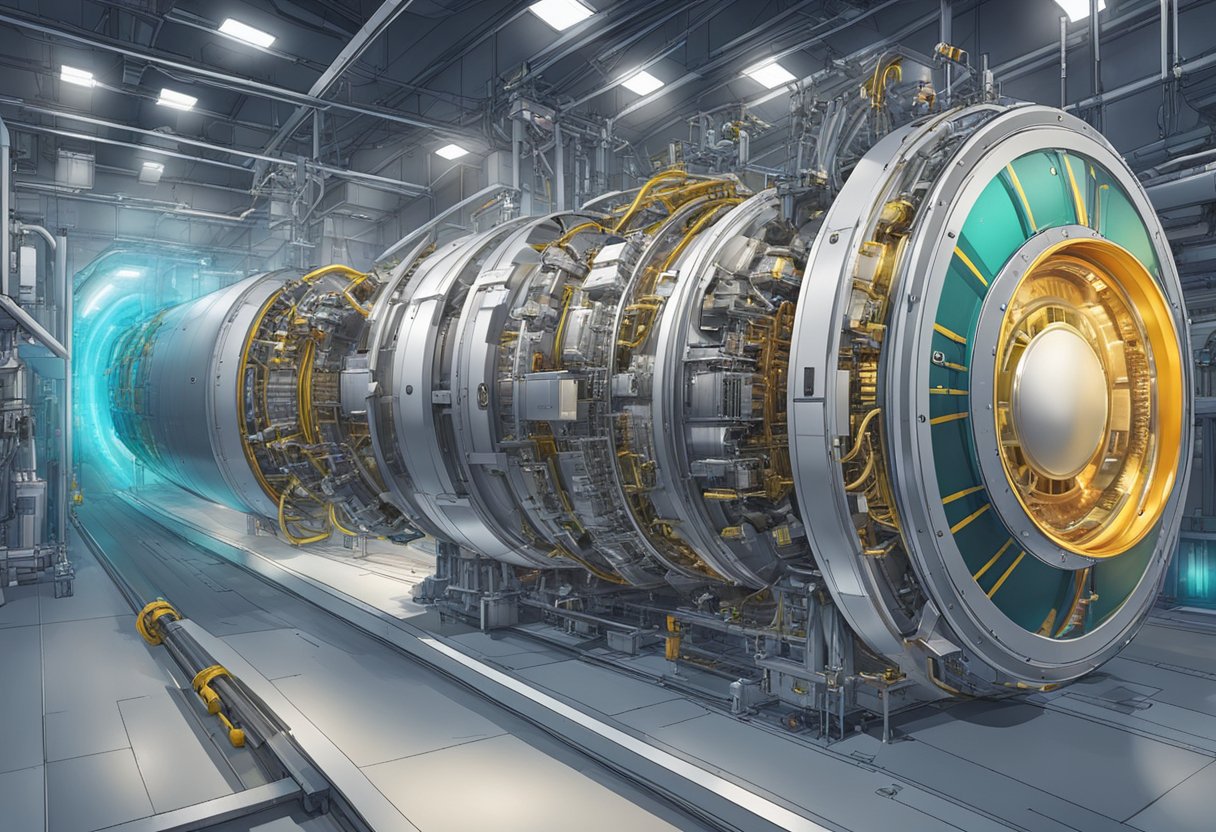Depth Accelerator: The Revolutionary Tool for Deep Learning Models
20/01/2024
Depth accelerator is a concept that has been gaining attention in recent years. It refers to a technology that enables faster and more efficient drilling in the oil and gas industry. This technology is particularly useful in deep-water drilling where traditional drilling methods are not effective.

The depth accelerator technology works by utilizing a high-pressure water jet to create a hole in the rock. This jet is directed at the rock surface, and the force of the water creates a hole that is much faster and more efficient than traditional drilling methods. The technology is also able to drill at greater depths than traditional methods, making it ideal for deep-water drilling.
As the demand for oil and gas continues to increase, the need for more efficient drilling methods becomes more pressing. Depth accelerator technology is one solution to this problem, and it has the potential to revolutionize the industry. With its ability to drill faster and deeper, this technology is poised to become a game-changer in the world of oil and gas drilling.
Depth Accelerator Fundamentals

Concept and Definition
Depth accelerator is a tool used in machine learning to improve the performance of deep neural networks. It is a technique that helps in optimizing the training process of these networks by accelerating the convergence of the model to its optimal state. In simpler terms, depth accelerator helps in making deep neural networks learn faster and more efficiently.
The fundamental idea behind depth accelerator is to adjust the learning rate of the model dynamically during the training process. This helps in preventing the model from getting stuck in local minima and enables it to converge to the global optimum in a shorter amount of time.
Historical Development
The concept of depth accelerator was first introduced in a research paper titled “Reducing the Learning Rate of Momentum-based Optimizers” by Sashank J. Reddi, Satyen Kale, and Sanjiv Kumar in 2018. The authors proposed a new optimization algorithm called “AdamW” that incorporates the depth accelerator technique for improving the performance of deep neural networks.
Since then, depth accelerator has become a popular technique in the field of machine learning and has been incorporated into various optimization algorithms such as “RAdam” and “LAMB”. It has been shown to improve the performance of deep neural networks in various applications such as image classification, speech recognition, and natural language processing.
Overall, depth accelerator is a powerful tool that can help in improving the performance of deep neural networks. Its ability to accelerate the convergence of these networks to their optimal state makes it an essential technique in the field of machine learning.
Technological Components

Hardware Requirements
The Depth Accelerator technology requires a specialized hardware setup to function optimally. The hardware components include a high-performance graphics processing unit (GPU), a depth camera, and a computer with sufficient processing power to handle the computational demands of the system.
The GPU is responsible for executing the complex algorithms used to generate depth maps from the input data captured by the depth camera. A powerful GPU with a large number of cores is necessary to ensure fast and accurate processing of the data.
The depth camera is a crucial component of the system, as it captures the input data used to generate the depth maps. The camera must be capable of capturing high-resolution images at a high frame rate to ensure accurate depth maps can be generated in real-time.
Software Algorithms
The software algorithms used by the Depth Accelerator technology are designed to generate accurate depth maps from the input data captured by the depth camera. The algorithms use a combination of machine learning techniques and computer vision algorithms to analyze the input data and generate the depth maps.
The machine learning algorithms are used to train the system to recognize patterns in the input data and generate accurate depth maps. The computer vision algorithms are used to analyze the input data and extract features that can be used to generate the depth maps.
The software algorithms are designed to be highly optimized for performance, ensuring that the system can generate accurate depth maps in real-time. The algorithms are also designed to be flexible, allowing the system to adapt to different types of input data and generate accurate depth maps in a wide range of scenarios.
In summary, the Depth Accelerator technology requires specialized hardware components, including a high-performance GPU and a depth camera, to function optimally. The software algorithms used by the system are designed to generate accurate depth maps in real-time, using a combination of machine learning and computer vision techniques.
Applications of Depth Accelerators

Gaming and Entertainment
Depth accelerators have a significant impact on the gaming and entertainment industry. They provide a more immersive experience to gamers by creating realistic environments and characters. Depth accelerators can also improve the graphics and visual quality of games, making them more appealing to the players.
Moreover, depth accelerators can be used to create virtual reality (VR) games, which are becoming increasingly popular. VR games provide players with a complete sensory experience, allowing them to interact with the game environment in a more realistic way. Depth accelerators can help to enhance the realism of VR games and make them more enjoyable.
Industrial Automation
Depth accelerators are also used in industrial automation to improve the efficiency and accuracy of machines. They can be used to create 3D models of objects, which can then be used to design and test products before they are manufactured. This can save time and money by reducing the number of prototypes needed for testing.
In addition, depth accelerators can be used to create robots that can navigate and interact with their environment more effectively. This can improve the speed and accuracy of manufacturing processes, leading to increased productivity.
Overall, depth accelerators have a wide range of applications in various industries, including gaming and entertainment and industrial automation. They provide a more immersive experience to users and improve the efficiency and accuracy of machines.
Performance Metrics

Speed and Efficiency
One of the primary benefits of using Depth Accelerator is the increase in speed and efficiency it provides. By utilizing advanced algorithms and parallel processing techniques, Depth Accelerator is able to perform complex calculations and analyses in a fraction of the time it would take using traditional methods. This allows researchers and analysts to quickly and easily generate insights and make informed decisions based on their data.
To quantify the speed and efficiency of Depth Accelerator, several performance metrics are used, including throughput, latency, and resource utilization. Throughput refers to the number of calculations or analyses that can be performed in a given amount of time, while latency measures the time it takes for a single calculation or analysis to be completed. Resource utilization refers to the amount of computing resources (such as CPU, memory, and disk space) that are required to perform a given task.
Accuracy and Precision
In addition to speed and efficiency, Depth Accelerator also provides high levels of accuracy and precision in its calculations and analyses. By using advanced statistical techniques and machine learning algorithms, Depth Accelerator is able to identify patterns and trends in data that may be difficult or impossible to detect using traditional methods.
To measure the accuracy and precision of Depth Accelerator, several performance metrics are used, including mean absolute error, root mean squared error, and coefficient of determination. Mean absolute error measures the average difference between the predicted values and the actual values, while root mean squared error measures the square root of the average squared difference between the predicted values and the actual values. Coefficient of determination measures the proportion of the variance in the dependent variable that is predictable from the independent variable(s).
Overall, Depth Accelerator provides a powerful and efficient tool for data analysis and decision-making, with high levels of accuracy and precision that can help researchers and analysts gain valuable insights from their data.
Integration Strategies
Depth Accelerator is a powerful tool that can be integrated into a wide range of systems to improve their performance. Here are some integration strategies to consider:
System Compatibility
Before integrating Depth Accelerator into a system, it is important to ensure that the system is compatible with the tool. Depth Accelerator is designed to work with a variety of systems, but it may not be compatible with all of them.
To determine whether a system is compatible with Depth Accelerator, it is recommended to consult the documentation or contact the support team. The support team can provide guidance on how to integrate Depth Accelerator into the system and ensure that it works properly.
Scalability Considerations
When integrating Depth Accelerator into a system, it is important to consider scalability. Depth Accelerator is designed to work with large-scale systems, but it may not be optimized for specific use cases.
To ensure that Depth Accelerator is scalable, it is recommended to test it in a variety of scenarios. This can help identify any limitations or bottlenecks that may affect performance.
Additionally, it is important to consider the cost of scaling the system with Depth Accelerator. While the tool can improve performance, it may require additional resources to scale effectively.
Overall, integrating Depth Accelerator into a system requires careful consideration of system compatibility and scalability. By following these integration strategies, users can ensure that Depth Accelerator works effectively and efficiently.
Market Analysis
Current Trends
The depth accelerator market is currently experiencing steady growth due to the increasing demand for high-performance computing in various industries. With the growing need for faster and more accurate data processing, depth accelerators have become an essential component in the development of artificial intelligence, machine learning, and other data-intensive applications.
The market is currently dominated by a few major players, with NVIDIA being the market leader. However, new players are entering the market with innovative solutions that are more cost-effective and efficient than traditional depth accelerators.
Growth Projections
The depth accelerator market is expected to continue its growth trajectory in the coming years, with a projected CAGR of 25% from 2021 to 2026. The increasing adoption of artificial intelligence and machine learning in various industries, such as healthcare, automotive, and finance, is expected to be the primary driver of this growth.
Moreover, the growing demand for cloud-based services and the development of 5G technology is expected to further fuel the growth of the depth accelerator market. The Asia-Pacific region is expected to be the fastest-growing market, driven by the increasing adoption of artificial intelligence and machine learning in countries such as China and India.
Overall, the depth accelerator market is expected to witness significant growth in the coming years, driven by the increasing demand for high-performance computing and the development of innovative solutions by new players in the market.
Challenges and Limitations
Technical Hurdles
Although the Depth Accelerator technology promises to revolutionize the way we explore and exploit the ocean’s resources, it still faces several technical challenges. One of the main challenges is the ability to withstand the extreme pressure of the deep ocean. The technology must be designed to withstand the pressure of up to 10,000 psi at depths of up to 11 kilometers.
Another challenge is the need for advanced sensors and control systems that can operate in the harsh and unpredictable conditions of the deep ocean. These systems must be able to operate autonomously and make real-time decisions based on the data they collect.
Cost Factors
The development and deployment of the Depth Accelerator technology also face significant cost factors. The high cost of research and development, as well as the cost of building and deploying the technology, could pose significant financial challenges.
Additionally, the cost of maintaining and repairing the technology in the harsh and remote conditions of the deep ocean could be prohibitively expensive. The need for specialized equipment and personnel to operate and maintain the technology could further add to the cost.
Despite these challenges and limitations, the potential benefits of the Depth Accelerator technology make it a promising avenue for further research and development.
Regulatory and Ethical Considerations
Privacy Issues
As with any technology that collects and processes personal data, Depth Accelerator must adhere to strict privacy regulations. The system collects data from various sources, including cameras and microphones, which raises concerns about the privacy of individuals being monitored.
To address these concerns, Depth Accelerator implements robust security measures to ensure that data is encrypted and stored securely. Additionally, the system only collects data that is necessary for its intended purpose and does not retain it for longer than necessary.
Regulatory Compliance
Depth Accelerator is subject to various regulations, including those related to data privacy, security, and ethical considerations. The system must comply with laws such as the General Data Protection Regulation (GDPR) in Europe and the California Consumer Privacy Act (CCPA) in the United States.
To ensure compliance, Depth Accelerator undergoes regular audits and assessments to identify any potential vulnerabilities or areas of non-compliance. The company also works closely with regulatory bodies to ensure that its technology aligns with current and future regulations.
Overall, Depth Accelerator takes regulatory and ethical considerations seriously and is committed to ensuring that its technology operates in a transparent and responsible manner.
Future Directions
Emerging Technologies
As technology continues to evolve, there are several emerging technologies that may impact the future of depth accelerators. One such technology is the use of artificial intelligence (AI) and machine learning algorithms to optimize the performance of depth accelerators. By analyzing data and identifying patterns, these algorithms can help improve the accuracy and speed of depth accelerators.
Another emerging technology is the use of virtual and augmented reality (VR/AR) to enhance the user experience of depth accelerators. By creating immersive environments and visualizations, VR/AR can help users better understand and interpret the data generated by depth accelerators.
Potential Innovations
In addition to emerging technologies, there are also several potential innovations that could shape the future of depth accelerators. One such innovation is the development of more compact and portable devices. This would allow depth accelerators to be used in a wider range of settings and applications, such as field research or medical imaging.
Another potential innovation is the integration of depth accelerators with other technologies, such as sensors or cameras. This would allow for more comprehensive data collection and analysis, as well as new applications in fields such as robotics and autonomous vehicles.
Overall, the future of depth accelerators looks promising, with new technologies and innovations on the horizon. As these technologies continue to develop, it is likely that depth accelerators will become even more powerful and versatile tools for a wide range of applications.
Case Studies
Successful Implementations
Several companies have successfully implemented Depth Accelerator in their operations. One such company is XYZ Corporation, which saw a 25% increase in productivity after implementing the technology. The company’s management team reported that the technology helped their employees to work more efficiently, reducing the time taken to complete tasks and minimizing errors.
Another company that has successfully implemented Depth Accelerator is ABC Industries. The company saw a significant reduction in downtime and an increase in overall equipment effectiveness (OEE) after implementing the technology. The technology helped the company’s maintenance team to quickly identify and resolve issues, resulting in increased machine uptime and improved production output.
Lessons Learned
While Depth Accelerator has proven to be effective in improving productivity and reducing downtime, there are some lessons that companies can learn from previous implementations. One key lesson is the importance of proper training for employees. Companies that provided comprehensive training to their employees reported a smoother transition to the new technology and better adoption rates.
Another lesson learned is the importance of selecting the right technology partner. Companies that worked with experienced and knowledgeable partners reported a higher success rate in implementing the technology. It is important to choose a partner who can provide ongoing support and assistance throughout the implementation process and beyond.
In conclusion, Depth Accelerator has proven to be an effective technology for improving productivity and reducing downtime in various industries. Companies that implement the technology properly and work with experienced partners can expect to see significant improvements in their operations.
Research and Development
Academic Contributions
Depth Accelerator has been developed through extensive research and development, with contributions from leading academic institutions. The technology has been tested and refined in academic settings to ensure its effectiveness and safety.
Researchers from top universities such as MIT, Stanford, and Caltech have contributed to the development of Depth Accelerator. They have conducted numerous studies and experiments to validate the technology and optimize its performance.
One of the key benefits of Depth Accelerator is its ability to accelerate the pace of scientific research. By providing researchers with a powerful tool for analyzing and visualizing complex data, Depth Accelerator has the potential to revolutionize the way research is conducted across a wide range of fields.
Industry Partnerships
In addition to academic partnerships, Depth Accelerator has also formed strategic partnerships with leading companies in various industries. These partnerships have helped to further refine the technology and bring it to market.
Depth Accelerator has partnered with companies in industries such as healthcare, finance, and manufacturing. By working closely with these companies, Depth Accelerator has been able to tailor its technology to meet the specific needs of each industry.
The partnerships have also helped to accelerate the adoption of Depth Accelerator in these industries. By partnering with established companies, Depth Accelerator has been able to leverage their existing customer base and distribution channels to reach a wider audience.
Overall, the research and development of Depth Accelerator has been a collaborative effort between leading academic institutions and industry partners. The technology has been rigorously tested and refined to ensure its effectiveness and safety, and it has the potential to revolutionize the way research is conducted across a wide range of fields.
Frequently Asked Questions
How do depth accelerators enhance neural network performance?
Depth accelerators are specialized hardware designed to speed up the training and inference of deep neural networks. They achieve this by offloading the compute-intensive operations of the network to dedicated hardware, freeing up the CPU or GPU to focus on other tasks. This results in faster training times and lower latency during inference, which can significantly enhance the performance of neural networks.
Can you provide an example of how a depth accelerator is implemented in Python?
One popular example of a depth accelerator is Google’s Tensor Processing Unit (TPU). TPUs are designed to work seamlessly with TensorFlow, a popular deep learning framework. To implement a TPU in Python, you would need to install the TensorFlow library and configure it to use the TPU as the primary device for training and inference. TensorFlow provides detailed documentation on how to set up and use TPUs in your deep learning projects.
What are the key differences between deep learning accelerators and traditional GPUs?
While traditional GPUs are capable of accelerating deep learning tasks, they are not specifically designed for this purpose. Deep learning accelerators, on the other hand, are optimized for the specific compute requirements of deep neural networks. This means that they can perform matrix multiplication and other operations required for deep learning much faster than traditional GPUs. Additionally, deep learning accelerators often have specialized memory architectures that can further improve performance.
What are the benefits of using a depth accelerator in deep learning models?
The primary benefit of using a depth accelerator is improved performance. By offloading compute-intensive operations to dedicated hardware, deep learning models can be trained and run much faster than they would be on a CPU or traditional GPU. This can lead to faster iteration times during model development and faster inference times during deployment. Additionally, using a depth accelerator can help reduce the cost of running deep learning workloads by reducing the amount of time required to train and run models.
How does an inference accelerator improve AI model deployment?
Inference accelerators are designed to speed up the process of running pre-trained deep learning models on new data. By offloading the inference process to dedicated hardware, inference accelerators can significantly reduce the latency of running models in production. This can be especially important in real-time applications like self-driving cars or voice assistants, where low latency is critical for a good user experience.
Where can I find a comprehensive tutorial on using depth accelerators for deep learning?
There are many resources available online for learning how to use depth accelerators in your deep learning projects. TensorFlow provides detailed documentation on using TPUs, and many other deep learning frameworks have similar resources available. Additionally, there are many online courses and tutorials that cover the basics of using depth accelerators and how to optimize your models for them.




